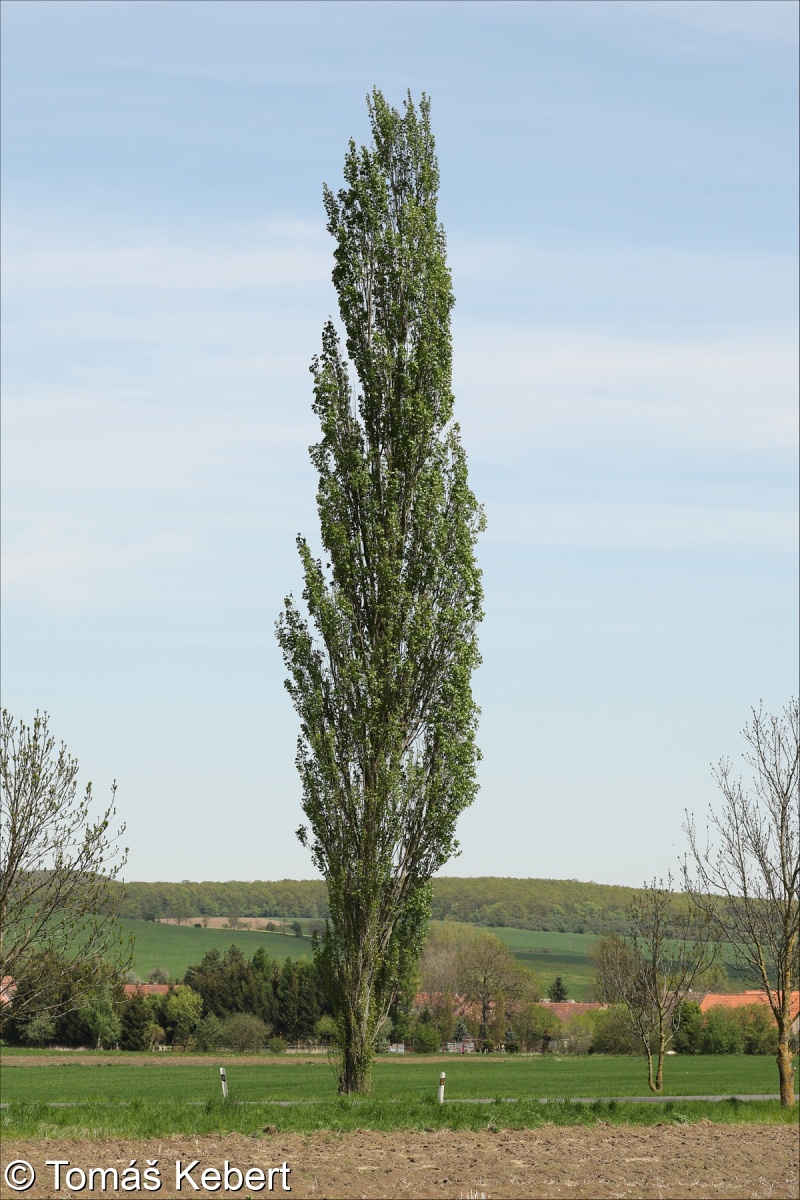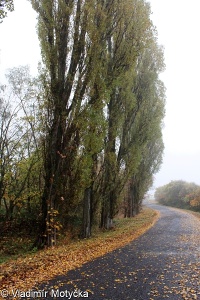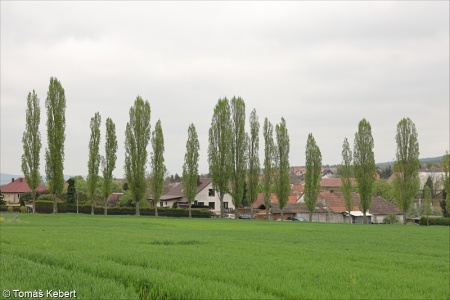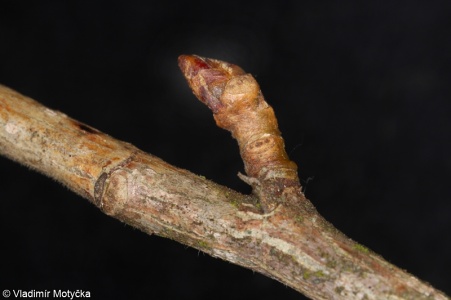Populus nigra ‘Italica’
Data
download factsheetHabitus and growth type
-
Life span: Perennial?
Life span
Life span categories reflect the length of life duration of individual species. Annual plants finish their life cycle within one growing season. Biennial or short-lived plants are overwintering, growing only vegetatively in the first season and fruiting in the following season/s. Most of them are monocarpic, i.e. they finish their life cycle after producing fruits. Perennial plants can stay in vegetative form for several seasons, repeatedly flower and produce seeds (polycarpic strategy). Some species were assigned to more than one category because of their different life span in different parts of Europe, e.g., annual life span in northern Europe and biennial or short-lived life span in the Mediterranean.
The data were compiled from Klotz et al. 2002, Săvulescu (1952-76) and complemented by additional sources such as national and regional floras. If possible we used also the life form assessment to decide the life span category.
Categories
- Annual
- Biennial or short-lived
- Perennial
Data source and citation
Dřevojan, P., Čeplová, N., Štěpánková, P., & Axmanová, I. (2023). Life span. – www.FloraVeg.EU.
Further references
Klotz, S., Kühn, I. & Durka, W. (2002). BIOLFLOR – Eine Datenbank zu biologisch-ökologischen Merkmalen der Gefäßpflanzen in Deutschland. Schriftenreihe für Vegetationskunde, 38, 1–334.
Săvulescu, T. (Ed.) (1952–1976). Flora Republicii Populare Române – Flora Republicii Socialiste România. Vols 1–13. București: Editura Academiei Republicii Populare Române, Academia Republicii Socialiste România. -
Life form: Phanerophyte, Tree?
Life form
The main categories of the life-form classification follow the system of Raunkiaer (1934), which is based on the position of the buds that survive the unfavourable season. In addition, we use auxiliary categories where it is possible to use finer differentiation.
At least one main category is assigned to each species, while some species can belong to more than one main category. Phanerophyte is a perennial woody or succulent plant with regenerative buds higher than 30 cm above the soil surface (includes trees, shrubs and tall succulents, excludes lianas and epiphytes). Chamaephyte is a perennial herb, low woody plant or succulent with regenerative buds above ground level, but not taller than 30 cm (includes dwarf shrubs, semi-shrubs, small succulents and some herbs). Hemicryptophyte is a perennial or biennial herb with regenerative buds on shoots at the ground level. Geophyte is a perennial plant with regenerative buds located belowground, usually with bulbs, tubers, or rhizomes. Hydrophyte is a plant that survives unfavourable seasons by means of buds that are at the bottom of a water body. Therophyte is a summer- or winter-annual herb that survives adverse seasons only as seeds and germinates in autumn, winter or spring. Epiphyte is either parasitic or non-parasitic plant that grows on other plants.
Auxiliary categories are only used for some species. Tree is a phanerophyte with a stem and a crown. Shrub is a phanerophyte branching from the stem base. Woody liana is a phanerophyte in the form of a long-stemmed woody vine. Semi-shrub (i.e. suffruticose chamaephyte) is a chamaephyte with shoots that usually grow straight up, bear leaves and flowers and die at the end of the growing season except for their lower part, which bears buds. Dwarf shrub is a chamaephyte with shoots that lignify instead of dying. Herbaceous liana is a hemicryptophyte, geophyte or therophyte with climbing aboveground stems.
Data were compiled from several databases and floras (Săvulescu 1952–1976, Horváth et al. 1995, Klotz et al. 2002, Tavşanoğlu & Pausas 2018, Guarino et al. 2019, Kaplan et al. 2019, French Flora database), European broad-scale studies (Wagner et al. 2017, Giulio et al. 2020), and different online sources (e.g. GreekFlora.gr). In the case of different assessments in original data sources, we critically revised them using additional sources.
Categories
- Phanerophyte
- Chamaephyte
- Hemicryptophyte
- Geophyte
- Hydrophyte
- Therophyte
- Epiphyte
- Tree
- Shrub
- Woody liana
- Semi-shrub
- Dwarf shrub
- Herbaceous liana
Data source and citation
Dřevojan, P., Čeplová, N., Štěpánková, P., & Axmanová, I. (2023) Life form. – www.FloraVeg.EU.
Further references
Giulio, S., Acosta, A. T. R., Carboni, M., Campos, J. A., Chytrý, M., Loidi, J., … Marcenò, C. (2020). Alien flora across European coastal dunes. Applied Vegetation Science, 23(3), 317–327. https://doi.org/10.1111/avsc.12490
GreekFlora.gr. Available at https://www.greekflora.gr/ [accessed June 2020]
Guarino, R., La Rosa, M. & Pignatti, S. (Eds) (2019). Flora d'Italia, volume 4. Bologna: Edagricole.
Horváth, F., Dobolyi, Z. K., Morschhauser, T., Lõkös, L., Karas, L. & Szerdahelyi, T. (1995). Flóra adatbázis 1.2 – taxonlista és attribútum-állomány. [FLORA database 1.2 – lists of taxa and relevant attributes.] Vácrátót: FLÓRA munkacsoport, MTA-ÖBKI, MTM Növénytára.
French Flora database (baseflor), project of Flore et végétation de la France et du Monde: CATMINAT. Available at http://philippe.julve.pagesperso-orange.fr/catminat.htm [accessed June 2020]
Kaplan Z., Danihelka J., Chrtek J. Jr., Kirschner J., Kubát K., Štěpánek J. & Štech M. (Eds.) (2019). Klíč ke květeně České republiky [Key to the flora of the Czech Republic]. Ed. 2. Praha: Academia.
Klotz, S., Kühn, I. & Durka, W. (2002). BIOLFLOR – Eine Datenbank zu biologisch-ökologischen Merkmalen der Gefäßpflanzen in Deutschland. Schriftenreihe für Vegetationskunde, 38, 1–334.
Raunkiaer C. (1934). The life forms of plants and statistical plant geography. Oxford: Clarendon Press.
Tavşanoğlu, Ç., & Pausas, J. (2018). A functional trait database for Mediterranean Basin plants. Scientific Data, 5, 180135. https://doi.org/10.1038/sdata.2018.135
Wagner, V., Chytrý, M., Jiménez-Alfaro, B., Pergl, J., Hennekens, S., Biurrun, I., … Pyšek, P. (2017). Alien plant invasions in European woodlands. Diversity and Distributions, 23(9), 969–981. https://doi.org/10.1111/ddi.12592
Săvulescu, T. (Ed.) (1952–1976). Flora Republicii Populare Române – Flora Republicii Socialiste România. Vols 1–13. București: Editura Academiei Republicii Populare Române, Academia Republicii Socialiste România.
Fruit, seed and dispersal
-
Dispersal mode: Anemochory?
Dispersal mode
Dispersal mode (dispersal syndrome, dispersal type) characterizes plant dispersal ability. It is represented by following categories: (i) local non-specific dispersal, which combines self-dispersal (autochory) and dispersal initiated by wind, where diaspores do not have any efficient special dispersal features, including several dispersal modes (namely ballochory, blastochory, boleochory, barochory); (ii) myrmecochory (ant dispersal); (iii) wind dispersal (anemochory), diaspores have special dispersal features such as hem, pappus, trichomes, dusty seeds or the species are tumbleweeds; (iv) animal dispersal includes dyszoochory, i.e. diaspores foraged by animals, which sometimes hide them as stock; (v) endozoochory, i.e. dispersal in animal gastrointestinal tract, and (vi) epizoochory, i.e., dispersal of diaspores attached on animal fur; special case is the (vii) anthropochory, i.e. human dispersal and (viii) hydrochory (water dispersal). Please note that hydrochory is not considered in the dispersal distance classes classification.
The dispersal modes are mainly estimated from species' morphological characteristics.
Categories
- Local non-specific dispersal
- Myrmecochory
- Anemochory
- Dyszoochory
- Endozoochory
- Epizoochory
- Anthropochory
- Hydrochory
Data source and citation
Lososová Z., Axmanová I., Chytrý M., Midolo G., Abdulhak S., Karger D.N., Renaud J., Van Es J., Vittoz P. & Thuiller W. (2023). Seed dispersal distance classes and dispersal modes for the European flora. Global Ecology and Biogeography, 32(9), 1485–1494.
Further references
Vittoz P. & Engler R. (2007). Seed dispersal distances: a typology based on dispersal modes and plant traits. Botanica Helvetica, 117, 109–124.
-
Dispersal distance class: 5?
Dispersal distance class
Dispersal distance classes are represented by ordered classes from 1 to 7, where classes 1 to 6 represent a gradient from short-distance dispersal to long-scale dispersal. The last class represents the dispersal mediated by humans. For species of the last class the assignment to the previous six classes and natural dispersal mode are given. The assignment of individual plants follows Lososová et al. (2023), a dataset prepared using the adjusted methodology of Vittoz & Engler (2007).
To assign plants into dispersal distance classes, several plant characteristics were obtained from various sources, namely plant height, life form, predominant dispersal mode, seed mass, typical habitat, plant geographical origin and information on dispersal by humans. In contrast to the original approach of Vittoz & Engler (2007), definitions of the dispersal distance classes were slightly modified.
Class 1 contains species shorter than 0.3 m. Their seeds do not have any specific dispersal features. Species are mostly self-dispersed, although seed dispersal can be initiated by wind, e.g., by shaking the fruit, which causes the diaspore to fall down. Class 2 is the most species-rich, including species with non-specific local dispersal strategy taller than 0.3 m. Class 3 includes ant-dispersed (myrmecochorous) species and wind-dispersed (anemochorous) forest herbs and dwarf shrubs. Class 4 is the least species-rich, including less efficient wind-dispersed woody plants and tumbleweeds. Class 5 includes wind-dispersed herbs and shrubs of open habitats and wind-dispersed trees with more efficient dispersal units (with trichomes). Class 6 includes species with different modes of animal dispersal. They can be dyszoochorous (i.e., foraged by animals, which sometimes hide them as stock), endozoochorous (i.e., dispersal in animal gastrointestinal tract), and epizoochorous (i.e., dispersal on animal fur). Finally, class 7 contains human-dispersed (antropochorous) species.
The species of the last class are also classified into one of the previous six classes based on their natural dispersal mode. Only classes 1-6 can be used in studies at the landscape scale where it is assumed that most species disperse naturally. All seven classes can be used in studies at a broader geographical scale where rare events of long-distance human dispersal are important.
Classes
- Class 1. Small plants without any specific dispersal features. Mean dispersal distance: 0.1–1 m.
- Class 2. Tall plants without any specific dispersal features. Mean dispersal distance: 1–5 m.
- Class 3. Wind-dispersed plants of forest understorey and ant-dispersed plants. Mean dispersal distance: 2–15 m.
- Class 4. Tumbleweed and wind dispersed trees and shrubs without trichomes. Mean dispersal distance: 40–150 m.
- Class 5. Wind dispersed trees and shrubs with trichomes and wind dispersal plants of open habitats. Mean dispersal distance: 10–500 m.
- Class 6. Animal dispersed plants. Mean dispersal distance: 400–1500 m.
- Class 7. Human dispersed plants. Mean dispersal distance: 500 –5000 m.
Data source and citation
Lososová Z., Axmanová I., Chytrý M., Midolo G., Abdulhak S., Karger D.N., Renaud J., Van Es J., Vittoz P. & Thuiller W. (2023). Seed dispersal distance classes and dispersal modes for the European flora. Global Ecology and Biogeography, 32(9), 1485–1494.
Further references
Vittoz P. & Engler R. (2007). Seed dispersal distances: a typology based on dispersal modes and plant traits. Botanica Helvetica, 117, 109–124.
Distribution
-
Country-based map: Not available
No subordinate taxa were found for this item.




